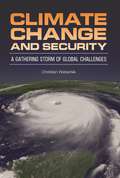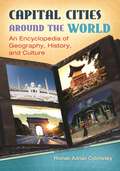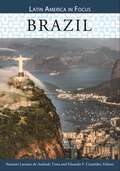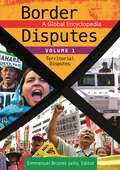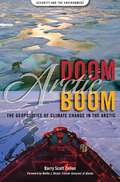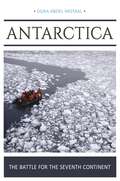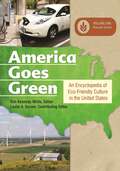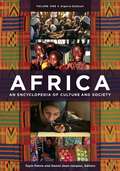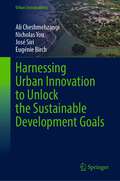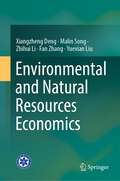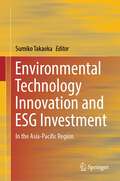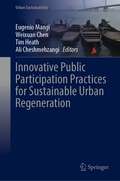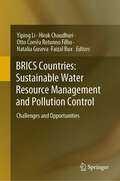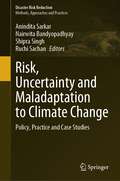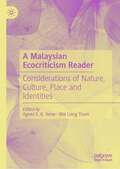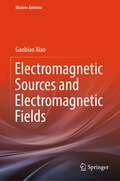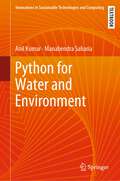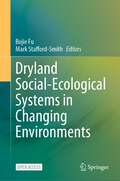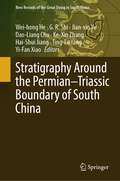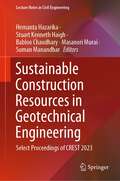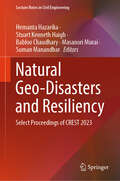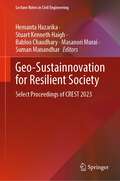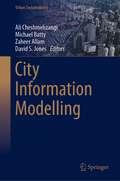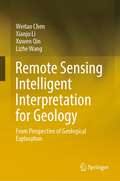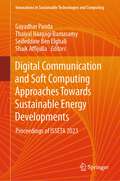- Table View
- List View
Climate Change and Security: A Gathering Storm of Global Challenges (Security and the Environment)
by Christian WebersikHuman-induced climate change is causing resource scarcities, natural disasters, and mass migrations, which in turn destabilize national, international, and human security structures and multiply the human inputs to climate change.Alarms about the expanding role of climate change as a force multiplier of existing threats to national, international, and human security structures studies are being raised at all levels of governance and intelligence—national (including the U.S. Senate, the Director of National Intelligence, the Central Intelligence Agency, and the Pentagon), transnational (including the European Union and the United Nations), and private (such as the Central News Agency and the American Security Project). Climate Change and Security: A Gathering Storm of Global Challenges focuses on the three major feedback effects of human-induced climate change on human and international security—resource scarcity, natural disasters, and sea-level rise. Decreasing per capita availability of renewable resources due to such regional effects of climate change as drought and desertification leads to intensified competition for these resources and may result in armed violence—especially when compounded by conditions of rapid population growth, tribalism, and sectarianism, as in Darfur and Somalia. The increase in the frequency and intensity of meteorological disasters associated with global warming weakens already debilitated tropical societies and makes them still more vulnerable to political instability, as in Haiti. Sea-level rise will lead to disruptive mass migrations of climate refugees as dense littoral populations are forced to abandon low-lying coastal regions, as in Bangladesh.
Capital Cities around the World: An Encyclopedia of Geography, History, and Culture
by Roman Adrian CybriwskyThis informative resource is a fascinating compilation of the history, politics, and culture of every capital city from around the world, making this the only singular reference on the subject of its kind.Every country, even the world's youngest nations, has a capital city—a centralized location which houses the seat of government and acts as the hub of culture and history. But, what role do capital cities play in the global arena? Which factors have influenced the selection of a municipal center for each nation? This interesting encyclopedia explores the topic in great depth, providing an overview of each country's capital—its history and early inhabitants, ascension to prominence, infrastructure within the government, and influence on the world around them. The author considers the culture and society of the area, discussing the ethnic and religious groups among those who live there, the major issues the residents face, and other interesting cultural facts.Capital Cities around the World: An Encyclopedia of Geography, History, and Culture features the capital cities of 200 countries across the globe. Organized in alphabetical order by country, each profile combines social studies, geography, anthropology, world history, and political science to offer a fascinating survey of each location.
Brazil (Latin America in Focus)
by Antonio Luciano de Andrade Tosta Eduardo F. CoutinhoIdeal for high school and undergraduate students, this one-stop reference explores everything that makes up modern Brazil, including its geography, politics, pop culture, social media, daily life, and much more.Home to the 2014 FIFA World Cup and the 2016 Summer Olympic Games—and one of the world's fastest-growing economies—Brazil is quickly becoming a prominent player on the international stage. This book captures the essence of the nation and its people in a unique, topically organized volume. Narrative chapters written by expert contributors examine geography, history, government and politics, economics, society, culture, and contemporary issues, making Brazil an ideal one-stop reference for high school and undergraduate students.Coverage on religion, ethnicity, marriage and sexuality, education, literature and drama, art and architecture, music and dance, food, leisure and sport, and media provides a comprehensive look at this giant South American country—the largest nation in Latin America as well as the fifth largest nation in the world. Students will be engaged by up-to-the-minute coverage of topics such as daily life, social media, and pop culture in Brazil. Sidebars and photos highlight interesting facts and people, while a glossary, a chart of holidays, and an annotated bibliography round out the work.
Border Disputes [3 volumes]: A Global Encyclopedia [3 volumes]
by Emmanuel Brunet-JaillyAn ideal resource for anyone studying current events, social studies, geopolitics, conflict resolution, and political science, this three-volume set provides broad coverage of approximately 80 current international border disputes and conflicts.Border disputes are a common source of political instability and military conflict around the globe, both in the present day and throughout history. Border Disputes: A Global Encyclopedia will serve as an invaluable resource for students studying social studies, political science, human geography, or related subjects. Each volume of this expansive encyclopedia begins with an accessible introduction to the type of dispute to be discussed, identifying the conflict as territorial (Volume 1), positional (Volume 2), or functional (Volume 3). Following the background essay in each volume are comprehensive case study entries on specific international conflicts, examining the disputed area, the reasons for the dispute, and cultural, political, historical, and legal issues relating to the dispute. The third volume will also provide primary documents of legal rulings and important resolutions of various disputes, as well as profiles of key organizations relating to border studies and specific border dispute commissions.
Arctic Doom, Arctic Boom: The Geopolitics of Climate Change in the Arctic (Security and the Environment)
by Dr. Barry Scott ZellenAn expert examination of the way climate change is transforming the Arctic environmentally, economically, and geopolitically, and how the challenges of that transformation should be met.A growing number of scientists estimate that there will be no summer ice in the Arctic by as soon as 2013. Are we approaching the "End of the Arctic?" as journalist Ed Struzik asked in 1992, or fully entering the "Age of the Arctic," as Arctic expert Oran Young predicted in 1986? Arctic Doom, Arctic Boom: The Geopolitics of Climate Change in the Arctic looks at the uncertainty at the top of the world as the shrinking of the polar ice cap opens up new sea lanes and the vast hydrocarbon riches of the Arctic seafloor to commercial development and creates environmental disasters for Arctic biota and indigenous peoples. Arctic Doom, Arctic Boom explores the geopolitics of the Arctic from a historical as well as a contemporary perspective, showing how the warming of the Earth is transforming our very conception of the Arctic. In addition to addressing economic and environmental issues, the book also considers the vital strategic role of the region in our nation's defenses.
Antarctica: The Battle for the Seventh Continent
by Doaa Abdel-MotaalThe thawing Antarctic continent offers living space and marine and mineral resources that were previously inaccessible. This book discusses how revisiting the Antarctic Treaty System and dividing up the continent preemptively could spare the world serious conflict.The Antarctic Treaty and related agreements—collectively known as the Antarctic Treaty System (ATS)—regulate the seventh continent, which is the only continent without a native human population. The main treaty within the ATS came into force in 1961 and suspended all territorial claims in Antarctica. The Antarctic Environmental Protocol followed in 1998 and prohibited any minerals exploitation in the continent. With this prohibition up for review in 2048, this book asks whether the Antarctic Treaty can continue to protect Antarctica. Doaa Abdel-Motaal—an expert on environmental issues who has traveled through the Arctic and Antarctic—explains that the international community must urgently turn its attention to examining how to divide up the thawing continent in a peaceful manner. She discusses why the Antarctic Treaty is unlikely to be an adequate measure in the face of international competition for invaluable resources in the 21st century. She argues that factors such as global warming, the growth in climate refugees that the world is about to witness, and the increasingly critical quest for energy resources will make the Antarctic continent a highly sought-after objective.Readers will come to appreciate that what has likely protected Antarctica so far was not the Antarctic Treaty but the continent's harsh climate and isolation. With Antarctica potentially becoming habitable only a few decades from now, revisiting the Antarctic Treaty in favor of an orderly division of the continent is likely to be the best plan for avoiding costly conflict.
America Goes Green [3 volumes]: An Encyclopedia of Eco-Friendly Culture in the United States [3 volumes]
by Leslie A. DuramThis three-volume encyclopedia explores the evolution of green ideology and eco-friendly practices in contemporary American culture, ranging from the creation of regional and national guidelines for green living to the publication of an increasing number of environmental blogs written from the layperson's perspective.Evidence of humanity's detrimental impact on the environment is mounting. As Americans, we are confronted daily with news stories, blogs, and social media commentary about the necessity of practicing green behaviors to offset environmental damage. This essential reference is a fascinating review of the issues surrounding green living, including the impact of this lifestyle on Americans' time and money, the information needed to adhere to green principles in the 21st century, and case studies and examples of successful implementation.America Goes Green: An Encyclopedia of Eco-Friendly Culture in the United States examines this gripping topic through 3 volumes organized by A–Z entries across 11 themes; state-by-state essays grouped by region; and references including primary source documents, bibliography, glossary, and green resources. This timely encyclopedia explores the development of an eco-friendly culture in America, and entries present the debates, viewpoints, and challenges of green living.
Africa [3 volumes]: An Encyclopedia of Culture and Society [3 volumes]
by Toyin Falola and Daniel Jean-Jacques, EditorsThese volumes offer a one-stop resource for researching the lives, customs, and cultures of Africa's nations and peoples.Unparalleled in its coverage of contemporary customs in all of Africa, this multivolume set is perfect for both high school and public library shelves. The three-volume encyclopedia will provide readers with an overview of contemporary customs and life in North Africa and sub-Saharan Africa through discussions of key concepts and topics that touch everyday life among the nations' peoples. While this encyclopedia places emphasis on the customs and cultural practices of each state, history, politics, and economics are also addressed. Because entries average 14,000 to 15,000 words each, contributors are able to expound more extensively on each country than in similar encyclopedic works with shorter entries. As a result, readers will gain a more complete understanding of what life is like in Africa's 54 nations and territories, and will be better able to draw cross-cultural comparisons based on their reading.
Harnessing Urban Innovation to Unlock the Sustainable Development Goals (Urban Sustainability)
by Ali Cheshmehzangi Nicholas You José Siri Eugénie BirchThis book first attempts to explore the nexus between urban innovation and sustainable development goals (SDGs). It puts together global examples of urban innovation initiatives, highlighting practical, policy-oriented, social, and technological interventions. The case studies are divided into four clusters of ‘green cities’, ‘inclusive cities’, ‘resilient cities’, and ‘healthy cities’. In doing so, the book maps various global examples of urban innovation for sustainable pathways and directions. It also highlights means of implementation of tool and technologies, data, financing, and governance. The overarching aim is to provide a holistic overview of urban innovation sustainable development nexus, which would help future policy development, paradigm shifts, and technological applications.By summarising a selection of successful initiatives, interventions, and projects, this book highlights how urban innovation could accelerate achieving SDGs. The lessons learned from each case study cluster are narrated as knowledge transfer platforms for future city development and achieving sustainable development. These lessons will be beneficial to practitioners and governments, as well as researchers and academics who are interested in urban innovation research. City case studies included in the book are based on their success stories as role models for other cities in developed and developing nations. This collection helps us portray a more holistic image of urban innovation aligned with the SDGs and pathways to achieving them.
Environmental and Natural Resources Economics
by Xiangzheng Deng Malin Song Zhihui Li Fan Zhang Yuexian LiuThis book aims to integrate multiple disciplinary such as management, economics, and geography from the perspective of resource science and also to strengthen research on resource management to promote sustainability in natural resources. It established clear definition of natural resources and in-depth exploration of main fields such as water resources, land resources, and agricultural resources. Classic methods of economics are applied to solve the problems of resource consumption, environmental pollution, and climate change in modern society. On the basis of classical economics, the disciplinary system of environmental and natural resources is further developed. It is a helpful reference for readers to further study natural resources and environmental economics.
Environmental Technology Innovation and ESG Investment: In the Asia-Pacific Region
by Sumiko TakaokaThis book focuses on environmental technology and financial markets of the Asia-Pacific region, which includes traditional and emerging innovative countries such as Japan, China, and South Korea. The research and its outcomes presented here are devoted to the nexus between innovation in environment-related technologies, finance, and environmental, social, and governance (ESG) issues. A promising means of achieving a sustainable society is to accelerate innovation in environmental technologies. Chapters of this book tackle some important issues. Using the data on environmental innovation creation and financial markets, the contributors identify three scopes in which ESG performance forms how investors evaluate corporate performance against climate-related risk in the Asia-Pacific capital markets (e.g., corporate bond and credit default swaps); how lenders allocate their credits according to carbon emissions in Japan; and what determines environmental technology creation and how it affects environmental improvement at a country-level. This book thus provides insights into the nexus between innovation in environment-related technologies, finance, and ESG.
Innovative Public Participation Practices for Sustainable Urban Regeneration (Urban Sustainability)
by Eugenio Mangi Weixuan Chen Tim Heath Ali CheshmehzangiThis book analyzes the adoption of stakeholders’ engagement in various fields and scales while providing the readers with an international outlook of the topic. In the contemporary processes of urban development, regeneration is becoming a relevant way to limit the occupation of new land and to enhance the existing spatial, social, and ecological dimensions of specific parts of the city. It generally entails the engagement of different groups of stakeholders and users at various levels—e.g., institutional and private—who carry on their own agendas while conveying a wide range of interests and values to safeguard. At the same time, despite indications of a significant increase in its implementation under various forms and in multiple contexts in the last twenty years, participatory mechanisms have not been without challenges and barriers due to several factors, including facilitators’ poor negotiation and communication practices, and consequently misinterpretation of the values at stake made by the parties involved, or obstructionism and gridlocks carried on by the different stakeholders. The narrative of the collection is structured in four sections The contributions elaborate on innovative participatory patterns, how they are/might be entangled with the different stages of regeneration projects, in what measure they have contributed to the United Nations sustainability goals, and the potential matters emerging during the negotiation phases. In detail, the four sections are: 1. Public space regeneration 2. Ecological regeneration 3. Built heritage regeneration 4. Informal settlements regeneration. Finally, this book is a significant asset to urban policy makers, planners, practitioners, and researchers in the architecture and urban studies domain who aim at deepening public participation practices knowledge by comparing different experiences.
BRICS Countries: Challenges and Opportunities
by Yiping Li Hirok Chaudhuri Otto Corrêa Rotunno Filho Natalia Guseva Faizal BuxThis book provides a detailed study and assessment of water resources management andpollution control in different BRICS countries. The regions involved areBrazil, Russia, India, China and South Africa. This book gives importantinsight into how future sustainability depends on the development of effectivewater governance mechanisms at the level of countries. According to theregional characteristics from different aspects it cuts into the waterenvironment problems and studies in different ways, which is multifaceted andtargeted. Using case studies that include environmentally integrated basinexperiments (eibex) of Brazil, groundwater overflow zone of India, semi-aridriver basin of South Africa and so on, this volume provides criticalinformation for researchers and policymakers.
Risk, Uncertainty and Maladaptation to Climate Change: Policy, Practice and Case Studies (Disaster Risk Reduction)
by Anindita Sarkar Nairwita Bandyopadhyay Shipra Singh Ruchi SachanThis book focuses on integrated disaster risk reduction arising out of climate change and shows how communities build resilience through adaptive and transformative strategies at the local and global levels. It integrates disaster risk, uncertainty, and maladaptation to climate change with evidence from empirical research and a systematic review of existing studies. The book also proposes two important contributions, which makes it distinctive. First, it gives a systematic review of the literature to capture the changing context and concept of risk, uncertainty, and maladaptation to climate change. Second, it uses case studies from around the globe to demonstrate the ways that communities have fostered to build resilience to mitigate the impacts of climate change.There is a growing recognition that decision-makers often rely on intuitive thinking processes rather than undertaking a systematic analysis of options in a deliberative fashion. This latter approach requires accepting a plurality of narratives, embracing multiple disciplinary perspectives, and above all, integrating the appropriate disciplines that can help in finding better solutions. Thus, the book adds value to the existing knowledge on climate change adaptation, perception, and policy initiatives to address disaster risk reduction. It considers all these interconnected issues of risk, uncertainty, and maladaptation through a series of conceptual review- and evidence-based case studies to create new knowledge to address climate change adaptation and a resilient future. The book is a useful contribution to resilience scientists, policymakers, and practitioners from diverse disciplines.
A Malaysian Ecocriticism Reader: Considerations of Nature, Culture, Place and Identities
by Agnes S. K. Yeow Wai Liang ThamThis collection of essays brings together ecocritical interpretations of Malaysian texts – including fiction, nonfiction, and other media / cultural expressions. It includes original works by environmental activists as well as emerging and established scholars, who collectively analyse various aspects of Malaysian ecological discourse.The contributors address crucial – and often controversial – topics such as local ecological imaginations, wildlife conservation, overdevelopment, postcolonial ecological identities, biopolitics, nature and sexuality, nature and race, the commodification of nature, nature–culture embodiments and entanglements, human–animal relations, waste and materiality, human and other-than-human agency, toxicity and slow violence, self-representations as well as attitudes towards land, nativity and indigeneity, migrancy and diaspora.Readers will gain valuable insights into the ways in which environments and ecological relationships are mediated within this national space, while opening up room to theorise beyond its boundaries.
Electromagnetic Sources and Electromagnetic Fields (Modern Antenna)
by Gaobiao XiaoThis book presents a modified spherical harmonic expansion method in which the electromagnetic fields and their sources are expanded with the same set of spherical vector basis functions in a similar procedure. Explicit expressions for the electromagnetic fields, potentials, energies, and the related Green’s functions are derived for the spherical modes in both frequency domain and time domain. Based on the formulation, the relationships between the electromagnetic sources, the electromagnetic far fields, and the electromagnetic near fields are clearly revealed. In particular, a nonuniform transmission line model is developed for intuitively characterizing the total radiation process. The introduction of the cutoff radius and the cutoff mode degree provides a simple reference for determining the numbers of degrees of freedom of the fields associated with sources in a bounded region. Based on the theory, an efficient hybrid method for synthesizing antenna arrays with complex footprints is proposed and demonstrated with several numerical examples. Effective algorithms are also developed for reconstructing the radiating part of the current sources.This book is intended for researchers, engineers, and graduate students who are interested in studying the energy transfer in electromagnetic radiation, synthesis and measurement of antenna arrays, and applications of inverse electromagnetic source problems.
Python for Water and Environment (Innovations in Sustainable Technologies and Computing)
by Anil Kumar Manabendra SahariaThis textbook delves into the practical applications of surface and groundwater hydrology, as well as the environment. The Part I, "Practical Python for a Water and Environment Professional," guides readers through setting up a scientific computing environment and conducting exploratory data analysis and visualization using reproducible workflows. The Part II, "Statistical Modeling in Hydrology," covers regression models, time series analysis, and common hypothesis testing. The Part III, "Surface and Subsurface Water," illustrates the use of Python in understanding key concepts related to seepage, groundwater, and surface water flows. Lastly, the Part IV, "Environmental Applications," demonstrates the application of Python in the study of various contaminant transport phenomena.
Dryland Social-Ecological Systems in Changing Environments
by Bojie Fu Mark Stafford-SmithThis open access book prepared by a joint working group committed to critical research on dryland social-ecological systems (SESs) presents a timely synthesis of up-to-date knowledge in various thematic fields relevant to dryland SESs. It aims to organize key salient concepts and establish a conceptual framework relevant to the interdisciplinary and cross-cultural understanding of dryland SESs, which have specific contexts and a geographically representative structure. Through synthesizing research across the world and analyzing scientific evidence for good practices, it has the potential to promote collaboration among global researchers as well as communication with policy makers, managers, and practitioners for dryland ecosystem management to promote sustainability. It calls for synergies between different sectors and countries to achieve Sustainable Development Goals in drylands.
Stratigraphy Around the Permian–Triassic Boundary of South China (New Records of the Great Dying in South China)
by Wei-Hong He G. R. Shi Jian-Xin Yu Dao-Liang Chu Ke-Xin Zhang Hai-Shui Jiang Ting-Lu Yang Yi-Fan XiaoThis book timely provides high-quality records of 32 PTB sections across different depositional settings from terrestrial to marine facies in South China, including descriptions of lithologies, high-resolution correlation of key boundaries and fossil occurrences at each section. This book also analyzes the patterns and processes of the community and ecosystem evolution over space and through time in the lead to the end-Permian mass extinction, and critically analyzes the mostly debated hypothesis, anoxia and volcanism, which were considered as the causes of mass extinction, based on the data from the studied sections of South China, together with materials from other regions of the world.
Sustainable Construction Resources in Geotechnical Engineering: Select Proceedings of CREST 2023 (Lecture Notes in Civil Engineering #448)
by Hemanta Hazarika Stuart Kenneth Haigh Babloo Chaudhary Masanori Murai Suman ManandharThis book presents select proceedings of the 2nd International Conference on Construction Resources for Environmentally Sustainable Technologies (CREST 2023), and focuses on sustainability, promotion of new ideas and innovations in design, construction and maintenance of geotechnical structures with the aim of contributing towards climate change adaptation and disaster resiliency to meet the UN Sustainable Development Goals (SDGs). It presents latest research, information, technological advancement, practical challenges encountered, and solutions adopted in the field of geotechnical engineering for sustainable infrastructure towards climate change adaptation. This volume will be of interest to those in academia and industry alike.
Natural Geo-Disasters and Resiliency: Select Proceedings of CREST 2023 (Lecture Notes in Civil Engineering #445)
by Hemanta Hazarika Stuart Kenneth Haigh Babloo Chaudhary Masanori Murai Suman ManandharThis book presents select proceedings of the 2nd International Conference on Construction Resources for Environmentally Sustainable Technologies (CREST 2023), and focuses on sustainability, promotion of new ideas and innovations in design, construction and maintenance of geotechnical structures with the aim of contributing towards climate change adaptation and disaster resiliency to meet the UN Sustainable Development Goals (SDGs). It presents latest research, information, technological advancement, practical challenges encountered, and solutions adopted in the field of geotechnical engineering for sustainable infrastructure towards climate change adaptation. This volume will be of interest to those in academia and industry alike.
Geo-Sustainnovation for Resilient Society: Select Proceedings of CREST 2023 (Lecture Notes in Civil Engineering #446)
by Hemanta Hazarika Stuart Kenneth Haigh Babloo Chaudhary Masanori Murai Suman ManandharThis book presents select proceedings of the 2nd International Conference on Construction Resources for Environmentally Sustainable Technologies (CREST 2023), and focuses on sustainability, promotion of new ideas and innovations in design, construction and maintenance of geotechnical structures with the aim of contributing towards climate change adaptation and disaster resiliency to meet the UN Sustainable Development Goals (SDGs). It presents latest research, information, technological advancement, practical challenges encountered, and solutions adopted in the field of geotechnical engineering for sustainable infrastructure towards climate change adaptation. This volume will be of interest to those in academia and industry alike.
City Information Modelling (Urban Sustainability)
by Ali Cheshmehzangi Michael Batty Zaheer Allam David S. JonesThis is the first book focused on City Information Modelling (CIM) that puts together a collection of recent studies related to concepts and trends in CIM, application and digitization processes/methods, and frameworks and practices of CIM. This emerging topic is important to various research and practice under sectors of the built environment, civil engineering, urban planning, urban design, and urban management. CIM aligns well with smart cities, data-driven urban analytics and optimization, information-based city planning, and future development paradigms. City Information Modelling provides global case study examples in three parts. At first, the contributors offer several examples of ‘Concepts and Trends’, where CIM is explored further in urban management, urban sustainability, and big data studies. In the second part, the book offers various examples of application and digitization processes or methods related to urban planning and design practices. In the third part, the contributors delve into several examples of CIM frameworks and practices critical to contemporary research, planning and design paradigms, and future practices. This collection is a niche resource for various stakeholders, particularly urban scientists, urban analytics, urban practitioners, and researchers. It will also be a valuable collection for those who work with information-based models, urban optimization models, and big data analytics, particularly from policy and practice perspectives. The findings of this collection help direct future research in CIM and suggest opportunities for big-data urban research, integrated urban models, and holistic frameworks in sustainable cities, smart cities, and future cities.
Remote Sensing Intelligent Interpretation for Geology: From Perspective of Geological Exploration
by Weitao Chen Xianju Li Xuwen Qin Lizhe WangThis book presents the theories and methods for geology intelligent interpretation based on deep learning and remote sensing technologies. The main research subjects of this book include lithology and mineral abundance. This book focuses on the following five aspects: 1. Construction of geology remote sensing datasets from multi-level (pixel-level, scene-level, semantic segmentation-level, prior knowledge-assisted, transfer learning dataset), which are the basis of geology interpretation based on deep learning. 2. Research on lithology scene classification based on deep learning, prior knowledge, and remote sensing. 3. Research on lithology semantic segmentation based on deep learning and remote sensing. 4. Research on lithology classification based on transfer learning and remote sensing. 5. Research on inversion of mineral abundance based on the sparse unmixing theory and hyperspectral remote sensing. The book is intended for undergraduate and graduate students who are interested in geology, remote sensing, and artificial intelligence. It is also used as a reference book for scientific and technological personnel of geological exploration.
Digital Communication and Soft Computing Approaches Towards Sustainable Energy Developments: Proceedings of ISSETA 2023 (Innovations in Sustainable Technologies and Computing)
by Gayadhar Panda Thaiyal Naayagi Ramasamy Seifeddine Ben Elghali Shaik AffijullaThis book is a second volume and contains selected papers presented at Second International Symposium on Sustainable Energy and Technological Advancements (ISSETA 2023), organized by the Department of Electrical Engineering, NIT Meghalaya, Shillong, India, during 24 – 25 February 2023. The topics covered in the book are the cutting-edge research involved in sustainable energy technologies, smart buildingtechnology, integration and application of multiple energy sources; advanced power converter topologies and their modulation techniques; and information and communication technologies for smart microgrids.
